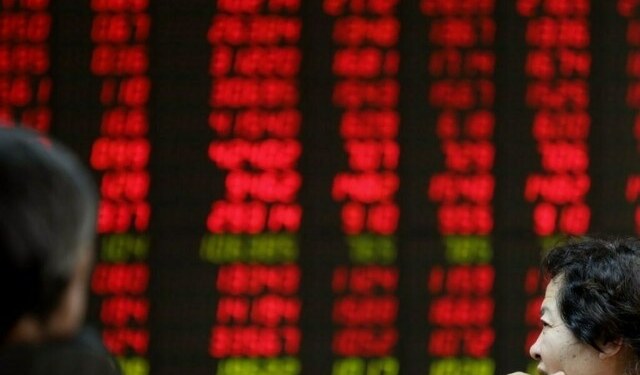By Marius Zaharia
HONG KONG (Reuters) – Asian exporters lost momentum last month even before tariffs on U.S. and Chinese goods kick in this week, pressuring regional factory activity in a worrying sign the Trump administration’s “America First” protectionist policies could derail global growth.
Shipments from China and Japan, major manufacturing hubs, contracted in June, while businesses across Asia also took on higher input costs as the price of oil and other commodities rose, according to monthly manufacturing surveys.
A separate Bank of Japan survey showed business confidence among big manufacturers worsening for a second straight quarter, in a blow for Abenomics and the Bank of Japan’s plans to wean the economy off stimulus.
Stocks eased and oil prices () fell as data across Asia showed world trade might have peaked, suggesting the strain on regional economies is likely to intensify as the effects of the heated Sino-U.S trade war ripple through global supply chains.
For graphic on Chinese markets had a bad month in June click https://reut.rs/2tDhc49
“We expect the net contribution of trade to growth to become negative in the second half of the year, if it hasn’t already for some countries,” ANZ Asia economist Eugenia Victorino said.
“The story for 2018 then becomes domestic demand, but it is not a homogenous story … and we don’t expect a homogenous reaction from Asian central banks.”
However, with the U.S. Federal Reserve increasingly hawkish on rates, hardly any Asian central bank has any room to support consumption as they need to keep their own rates relatively high to prevent destabilizing capital outflows.
CHINA PRESSURED
Apart from China potentially cutting reserve requirements further this year, no other central bank is seen easing monetary policy, and the countries running current account deficits may have to hike rates further.
China’s Caixin/Markit Manufacturing Purchasing Managers’ index (PMI) declined to 51.0 in June from May’s 51.1,with a subindex showing new export orders contracting for the third straight month and the most in two years.
An official PMI survey on Saturday also fueled concerns about the strength of the world’s second largest economy, where recent data including credit growth, investment and retail sales have disappointed.
The economy is feeling the pinch of an internal crackdown on debt and risky financing as well as external pressure from U.S. President Donald Trump’s ‘America First’ protectionist policies. The United States has threatened to impose duties on up to $450 billion of Chinese imports, with the first $34 billion portion set to go into effect on July 6. Beijing plans to retaliate.
This has caused anxiety in financial markets, leading to the worst performance on record for the yuan and the deepest monthly fall in Chinese stocks since January 2016.
“The latest PMI readings suggest that the economy lost some momentum last month. With credit growth still cooling and U.S. tariffs imminent, we expect further weakness ahead,” said Julian Evans-Pritchard, senior China economist at Capital Economics.
For graphic on major seaborne oil exports to Asia click https://reut.rs/2KD6Es5
BAD MONTH
Other Asian economies have also had a bad month. The Indian rupee
After a surprise 50 basis points increase on Friday, on top of two earlier 25 bps hikes, Bank Indonesia has become the most hawkish central bank in Asia as it focuses on stabilizing its markets, albeit at the expense of economic growth.
India has raised rates once and the Philippines twice. Both may hike further as their currencies, stocks and bonds are being punished by investors, nervous about current account deficits in a world where money gets scarcer and less cheap.
“BI are very aggressive, but pretty pre-emptive and that sends a good message for the market,” said Jean-Charles Sambor, deputy head of emerging markets fixed income at BNP Paribas (PA:) Asset Management.
“In the short-term India and the Philippines could be seen as a little bit behind the curve, but in the long run we don’t believe that we will see an emerging market currency crisis there. It could be that they’ve taken a more gradual path.”
Indonesia’s factory activity was the slowest since January, South Korea’s contracted for a fourth straight month, while in Malaysia the pace of deterioration eased slightly as activity recovered from the uncertainty related to the country’s shock election victory for the opposition.
Taiwan and Vietnam posted stronger results. India’s factories were also in good fettle last month, with solid overseas demand.
NO EXIT
Japan’s June manufacturing PMI showed growth, but export orders contracted.
Together with BOJ’s “tankan” survey, the data raises worries that the “Abenomics” stimulus program is sputtering just as the government and the central bank wanted to tap the brakes.
The yen, seen as a safe haven, has gained on the back of the U.S.-China trade worries, further weighing on Japanese exporters.
“The tankan shows the economy remains on solid footing, but it is not strong enough to allow the BOJ to head for the exit,” Hiroshi Miyazaki, senior economist at Mitsubishi UFJ Morgan Stanley (NYSE:) Securities.
Source: Investing.com




























